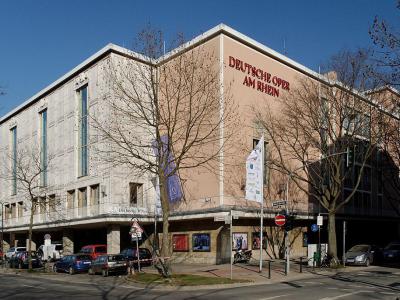
Opernhaus (Opera House), Dusseldorf
The Dusseldorf Opera House, located on Heinrich Heine Avenue at the edge of the historic city center, serves as both the performance venue and administrative headquarters of the German Opera on the Rhine. Originally constructed between 1873 and 1875 by architect Ernst Giese, this opera house was initially known as City Theater (Stadttheater). Featuring an Italian Renaissance-inspired round frontage and seating for 1,260, the design closely mirrored iconic theaters like the Semperoper in Dresden. Despite being only partially completed by its inauguration on November 29, 1875, the theater continued operating under city management.
In the following decades, the opera house underwent several transformations. By 1925, it had been renamed Opera House, differentiating it from a nearby Operetta Theater. However, the venue was heavily bombed in 1943, reducing seating capacity to 1,000 as repairs allowed performances to continue until 1944. After World War II, extensive restoration and modernization began in 1954, culminating in a reopening in 1956 with Beethoven’s Fidelio. The redesigned space, with a 1,342-seat auditorium and a blend of 1950s stylistic elements, has since gained protected monument status.
Dusseldorf’s opera house also plays a pivotal role in the regional opera scene, reconnecting with Duisburg as part of the German Opera on the Rhine. Major renovations in 2006-2007 brought further modernization, including a striking glass-walled rehearsal studio for ballet and orchestra, facing the Hofgarten and Konigsallee. Today, the opera house accommodates up to 1,296 guests and features a renowned costume collection of 50,000 items, showcasing its rich history on guided tours.
In the following decades, the opera house underwent several transformations. By 1925, it had been renamed Opera House, differentiating it from a nearby Operetta Theater. However, the venue was heavily bombed in 1943, reducing seating capacity to 1,000 as repairs allowed performances to continue until 1944. After World War II, extensive restoration and modernization began in 1954, culminating in a reopening in 1956 with Beethoven’s Fidelio. The redesigned space, with a 1,342-seat auditorium and a blend of 1950s stylistic elements, has since gained protected monument status.
Dusseldorf’s opera house also plays a pivotal role in the regional opera scene, reconnecting with Duisburg as part of the German Opera on the Rhine. Major renovations in 2006-2007 brought further modernization, including a striking glass-walled rehearsal studio for ballet and orchestra, facing the Hofgarten and Konigsallee. Today, the opera house accommodates up to 1,296 guests and features a renowned costume collection of 50,000 items, showcasing its rich history on guided tours.
Want to visit this sight? Check out these Self-Guided Walking Tours in Dusseldorf. Alternatively, you can download the mobile app "GPSmyCity: Walks in 1K+ Cities" from Apple App Store or Google Play Store. The app turns your mobile device to a personal tour guide and it works offline, so no data plan is needed when traveling abroad.
Opernhaus (Opera House) on Map






Sight Name: Opernhaus (Opera House)
Sight Location: Dusseldorf, Germany (See walking tours in Dusseldorf)
Sight Type: Attraction/Landmark
Sight Location: Dusseldorf, Germany (See walking tours in Dusseldorf)
Sight Type: Attraction/Landmark
Walking Tours in Dusseldorf, Germany
Create Your Own Walk in Dusseldorf
Creating your own self-guided walk in Dusseldorf is easy and fun. Choose the city attractions that you want to see and a walk route map will be created just for you. You can even set your hotel as the start point of the walk.
Rhine River Promenade Walk
The scenic Rheinuferpromenade (Rhine Promenade) is the lifeline of Dusseldorf. Currently one of the most beautiful places in the city and a very popular destination for both locals and tourists, this approximately 1.5-kilometer-long embankment was developed between 1990 and 1997 to a design by architect Niklaus Fritschi.
The project was easily one of the most successful waterfront... view more
Tour Duration: 1 Hour(s)
Travel Distance: 2.4 Km or 1.5 Miles
The project was easily one of the most successful waterfront... view more
Tour Duration: 1 Hour(s)
Travel Distance: 2.4 Km or 1.5 Miles
Dusseldorf Introduction Walking Tour
The area at the confluence of the Rhine and Dussel rivers was on the outskirts of the Roman Empire and settled by Germanic fishing tribes. It is from these small beginnings that the town takes its name. "Dorf" translates to "village" in English. The city of Dusseldorf has since grown far larger than that original eighth-century fishing village.
Dusseldorf was first elevated... view more
Tour Duration: 2 Hour(s)
Travel Distance: 2.3 Km or 1.4 Miles
Dusseldorf was first elevated... view more
Tour Duration: 2 Hour(s)
Travel Distance: 2.3 Km or 1.4 Miles
Dusseldorf's Old Beer (Altbier) Walk
Just as London has given us Porter, Dublin – Stout, Burton – the original (English) IPA, and Cologne – Kolsch, Dusseldorf has contributed to the world of beers its signature Altbier. They say, Dusseldorf and Altbier go together like onion rings and blood sausage. Curiously enough, though, this delicious, cool-fermented and malty brew, ranging in color from dark brown to copper, is not... view more
Tour Duration: 1 Hour(s)
Travel Distance: 1.1 Km or 0.7 Miles
Tour Duration: 1 Hour(s)
Travel Distance: 1.1 Km or 0.7 Miles



